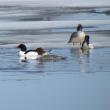Woodpecker Ducks
As you may know, the wood duck (as its name sort of implies) is a species that nests in tree cavities. Birds that nest in tree cavities can often be enticed into using human-made nest boxes if they are of the right size and placed in the types of habitats preferred by that species. Most of us have seen a shallow wetland area somewhere in Maine (or across much of the U.S. and southern Canada) adorned with one or more large nest boxes on poles. Anyone who has traveled the Interstate 95 corridor here in Maine has likely seen some of these as you zoomed by open ponds in areas like Richmond and Augusta. Those nest boxes were put up to provide nesting sites for wood ducks. Of course, most wood ducks still nest in tree cavities, where the female lays 10 or so eggs and incubates them for about a month. Soon after hatching, the young follow the hen out of the nest cavity and drop to the ground, usually without injury, where the female gathers them together and leads them to the nearest body of water.
Cavity nesting is quite rare in the waterfowl world. Almost all ducks and geese nest on the ground. But along with the wood duck, a number of the ducks that we are most used to seeing in winter here in Maine also nest in tree cavities. The smallest and perhaps most familiar of these is the bufflehead. We have written before about various interesting things related to the beloved bufflehead. Small flocks of these tiny ducks, the males with the big white triangular patch on their otherwise dark heads, begin arriving along the Maine coast in October and November. Just about every cove and bay seems to have its resident flock that spends the winter diving for small crustaceans in shallow waters near shore. Many a bird lover has enjoyed watching them from a warm living room as the birds dive and bob in the cold waters on a blustery day. Nesting almost exclusively in Canada and Alaska (except for a few in the mountains of the western U.S.), buffleheads nest in tree cavities near small, shallow lakes particularly in the Boreal Forest ecoregion. The nesting sites chosen are often in aspens (also known as poplars) and are usually within a few hundred yards of water.
The larger common goldeneye, another regular winter bird of the bays and coves of Maine’s coast, also nests in tree cavities. Its close relative, the Barrow’s goldeneye, a more uncommon winter bird of our area more regularly found in or at the mouths of rivers here (though sometimes seen at Ocean Point), is another cavity-nester. And both the relatively large common merganser and tiny hooded merganser nest in tree cavities as well. Interestingly, the red-breasted merganser is not a cavity-nester but places its nest right on the ground, sometimes within an island tern colony. The common goldeneye, common merganser, and hooded merganser all nest here in Maine and so can sometimes be seen on lakes and ponds in summer, the females trailing a line of downy chicks.
One look at any of these cavity-nesting ducks would provide clear evidence that they would not likely be able to chip away at even a rotting tree in order to construct a cavity in which to nest. That’s why we like to call them the “woodpecker ducks.” In most studies in which researchers have been able to locate natural nest sites for these ducks, they use cavities originally constructed by woodpeckers. For the small bufflehead, the woodpecker on which they are most dependent seems to be the northern flicker. Pileated woodpeckers provide nest cavities for the larger ducks in higher proportion. Probably other woodpecker species occasionally do as well. Of course, the woodpeckers are originally making the cavities for their own use and once in a while a conflict can ensure. One ornithologist documented a pileated woodpecker driving a female wood duck from a tree cavity that it intended to use!
Trees that are big enough and have some soft spots for excavating are also old trees; in fact, studies have found that, depending on the forest type, trees most likely to have lots of potential nest cavities will be 80-200 years old. Obviously this requires that large tracts of forest with nearby wetlands be allowed to reach a ripe old age if we want to have both woodpeckers and the wonderful woodpecker ducks on which they are so dependent.
Jeffrey V. Wells, Ph.D., is a Fellow of the Cornell Lab of Ornithology. Dr. Wells is one of the nation's leading bird experts and conservation biologists and author of the “Birder’s Conservation Handbook.” His grandfather, the late John Chase, was a columnist for the Boothbay Register for many years. Allison Childs Wells, formerly of the Cornell Lab of Ornithology, is a senior director at the Natural Resources Council of Maine, a nonprofit membership organization working statewide to protect the nature of Maine. Both are widely published natural history writers and are the authors of the book, “Maine’s Favorite Birds” and the just-released “Birds of Aruba, Bonaire, and Curaçao.”
Event Date
Address
United States






















